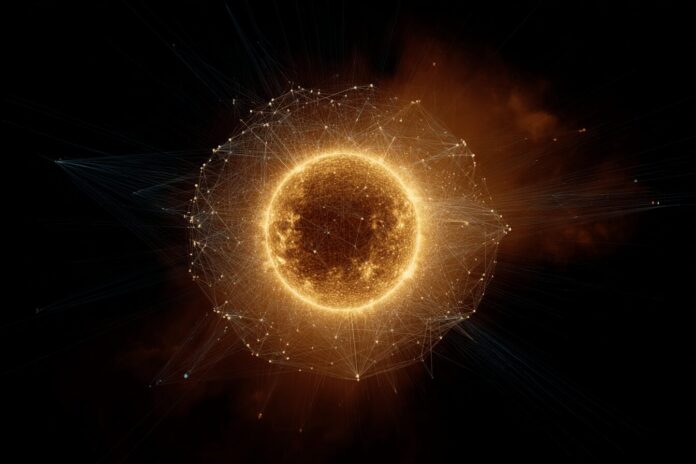Surya is the world’s first open-source AI model trained specifically to predict violent solar storms — a breakthrough by NASA and IBM. This revolutionary technology leverages deep learning algorithms to analyze vast amounts of solar data, thereby protecting crucial Earth and space-based technologies from the Sun’s unpredictable outbursts. Because space weather can disrupt everyday technology and even endanger human life, Surya’s development marks a significant step forward in heliophysics and predictive science.
Most importantly, this new technology not only prevents potential widespread communication blackouts and power outages but also safeguards satellites and astronauts from the hazardous impacts of solar flares. Therefore, by predicting solar storms with unprecedented accuracy, Surya represents the dawn of an era where cutting-edge AI meets practical space weather monitoring.
Understanding the Need for Solar Storm Prediction
Solar flares and coronal mass ejections (CMEs) are powerful phenomena that emit vast amounts of energy and charged particles. They occur on the Sun and have the potential to disrupt everything from GPS systems to global power grids. Because modern society relies heavily on technology, any interference—even for a few moments—can lead to significant consequences. In addition, airlines and space missions are particularly vulnerable, given the high precision required for safe and efficient operations.
Besides that, early warnings of solar activity are crucial for mitigating risks. For example, grid operators can isolate parts of a network and power down sensitive equipment in advance, and space agencies can provide timely alerts to protect astronauts. With these measures in place, the impact of solar storms can be managed before they escalate into disasters. For more detailed insights, refer to Live Science and SiliconANGLE.
How Surya Leverages Advanced AI for Solar Forecasting
Traditional solar weather prediction relied on fragmented satellite data and historical trends that did not capture the real-time complexity of solar activity. In contrast, Surya utilizes one of the largest high-resolution heliophysics datasets ever assembled. This dataset, sourced from NASA’s Solar Dynamics Observatory (SDO), contains detailed images that reveal microscopic changes on the solar surface. Because these images are ten times larger than common AI datasets, they provide a rich foundation for training precision models.
In addition, Surya employs advanced convolutional neural networks and machine learning architectures designed specifically to process enormous volumes of solar imagery. Consequently, the model can forecast solar flares up to two hours in advance by detecting subtle changes in active regions and radiation patterns. Most importantly, initial tests indicate a 16% increase in accuracy over previous methodologies, which is critical for operational use in fields that require precise timing and rapid decision-making. Learn more about these technological advances on CNET.
The Power of Open-Source Collaboration in Space Weather Research
One of the most transformative aspects of the Surya model is its open-source nature. By making Surya available on the Hugging Face platform, NASA and IBM are encouraging global collaboration in space weather prediction. This democratization of technology means that researchers, universities, and industry leaders can adapt and improve on the model according to regional and technical needs, thereby enhancing its utility even further. Because shared knowledge accelerates innovation, the open-source release is expected to spur developments in both commercial and scientific communities.
Furthermore, this collaborative approach allows enhancements in related fields such as climate modeling and geospatial analysis. For instance, IBM and NASA’s other foundation model, Prithvi, is already making waves by enabling advanced geospatial studies. Therefore, Surya not only sets new standards in heliophysics but also exemplifies the future of cross-disciplinary, open-source innovation. Additional insights on the collaboration can be found at Database Trends & Applications.
Enhancing Infrastructure Protection and Expanding Scientific Research
Modern infrastructure relies on uninterrupted operation of satellites, power grids, and communication networks. A major solar storm has the potential to bring these systems to a standstill, causing widespread disruption. Because early warning is essential, Surya’s ability to forecast extreme solar events, including potential “Carrington-class” storms, plays a crucial role in infrastructure protection. This technology gives operators the time to implement protective measures such as power-down procedures for satellites or shielding for sensitive ground electronics.
Moreover, the advancements provided by Surya are not only of immediate practical importance but also push the boundaries of scientific exploration. Besides that, the integration of AI into space weather monitoring opens the door for new research initiatives focused on understanding the Sun’s behavior at a granular level. Therefore, Surya is set to become an invaluable tool in expanding our collective scientific knowledge and protecting vital technological assets from solar hazards.
The Future: AI-Powered Space Weather and Beyond
Looking forward, Surya’s deployment signals a transformative shift in how we approach space weather prediction. As solar activity increases heading into its next cycle, the potential for significant solar events grows. In response, AI models like Surya are evolving rapidly, integrating real-time data streams with sophisticated algorithms that offer unprecedented forecast accuracy. Most importantly, these innovations enable us to pre-emptively adapt to space weather challenges, ensuring that modern technology remains resilient.
Because the threats posed by solar storms are global, multinational collaborations and open-source frameworks are vital. As researchers continue to refine these technologies, the groundwork is laid for even more robust defense mechanisms against natural cosmic hazards. Therefore, Surya is not simply a singular achievement but a harbinger of a future where AI continually safeguards our planet’s most critical systems.
References
- Live Science – IBM and NASA create first-of-its-kind AI that can accurately predict solar flares (2025)
- SiliconANGLE – IBM’s and NASA’s Surya AI Model (2025)
- The European – IBM NASA solar flare AI: Surya Forecasts
- Database Trends & Applications – IBM and NASA Release Open-Source AI Model (2025)
- CNET – Meet Surya, a New AI Model From NASA and IBM



